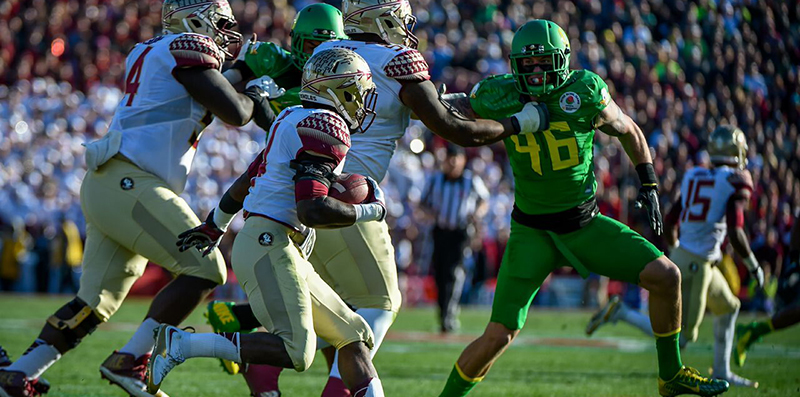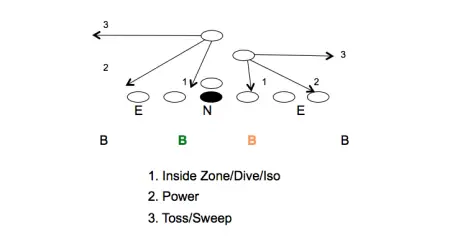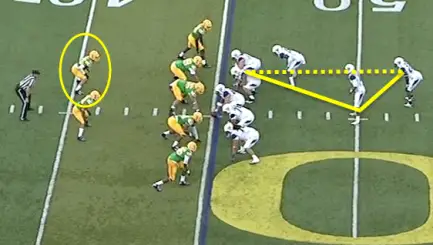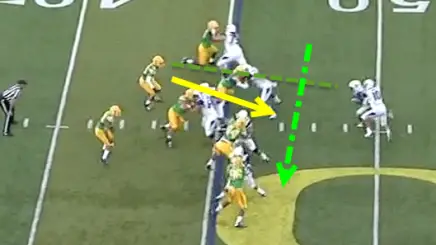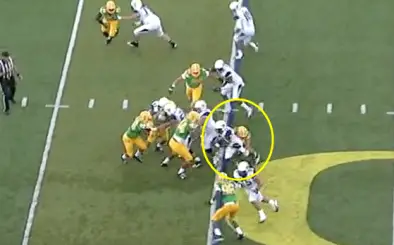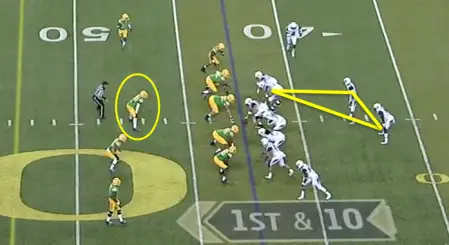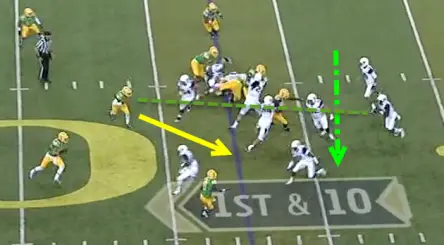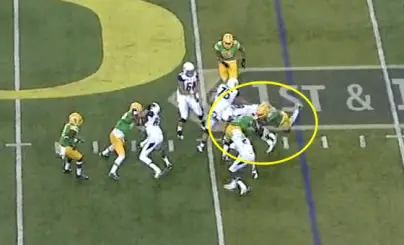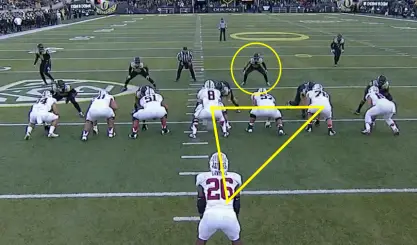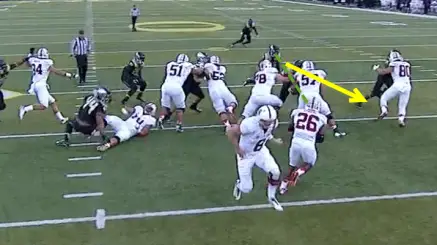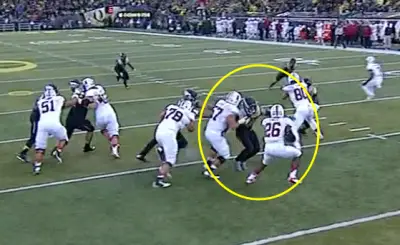When looking at Oregon’s linebacker unit from 2014, a common theme often arises — inconsistency.
FishDuck.com discussed it here and here, as others did here.
In my experience, inconsistency typically stems from player inexperience and mental overload, both of which seemed to be confounding factors for the Oregon linebacking crew — as they were a bit inexperienced and working under a new defensive coordinator — Don Pellum — in 2014.
These factors work to erode a player’s ability to execute fundamentals and play fast, both of which are integral to success on the field. For this analysis, we will look at how an inside linebacker reads keys to make plays in the run game and at the same time, show why Duck fans have hope for more consistent linebacker play in 2015.
Linebacker Reads
One of the most difficult skills for a linebacker to learn is ‘play evaluation and reaction.’ Considering the complexity of modern offensive football and the amount of misdirection that can occur, it is not surprising that development takes time. Fortunately, players can and do get better at this with more repetitions on the field.
Basically, this skill comes down to reads, keys and developing an understanding of the concepts of the offense you are facing. A key is someone or something that the linebacker can watch in order to best evaluate the play and decide what his response should be. While there are always different ways of doing things, typically, linebackers will be taught to “read a triangle.”
Reading the Triangle
The triangle concept is predicated on reading three points within the offensive formation as the play develops. If done properly, the defender will be able to react quickly and be in position to make a play or fulfill his defensive responsibility, such as the cut-back lane, gap control and more.
The triangle I used most often involved reading the (1) near guard, (2) near back, and (3) quarterback.
The image above illustrates the two triangle reads for the inside backers against a Strong-I formation.
Reading the Near Guard
The first read is typically the guard, as most of the time — false pulls notwithstanding — the guard will tell you what the play is going be.
The first read to make is often the ’hat height’ – the helmet – of the offensive guard. Typically, if the guard comes upward out of his stance and shows the backer a high hat? That means the LB should look for a pass, while a low hat means run blocking — or a running play. Obviously, offenses do things to break reads and keys, such as run draws and play-action passes — but that discussion is beyond the scope of this article.
Once the ‘backer knows if it is run or pass, he must then determine the direction of the play. This is first done by continuing to key the guard; is he down blocking, zone blocking, pulling or releasing immediately to the second level?
Once this read is made, the key should shift to the backfield.
Reading the Near Running Back
If the linebacker got a run read from the guard, he will focus on the near back and assess his path, as indicated in the image above. As you can see, there are three basic paths that the RB can take, and each represents a different play concept.
Each linebacker then has a different ‘run fit’ — assignment — to execute based on the running back’s action and the philosophy of the defense.
Reading the Quarterback
If the linebacker got a ‘pass’ read from the guard, he will shift his focus to the quarterback and assess the drop depth. His assignment will depend on the called coverage, the game plan, and what he continues to see.
Generally, though, if the QB takes a 3-step drop, the ‘backer should be looking for quick pass patterns such as slants and 4-7 yard drags. If the QB takes a deeper 5-step drop, the backer should be looking for deeper pass routs such as hooks, curls or deeper drags.
Film Break Down
Let’s take a look at some great plays by linebackers from the 2014 season and see how their reading process allowed them to execute well.
Clip #1
In the screenshot above, we see the Oregon defense lined up against an open 1-back set and the top linebacker, Joe Walker, is set and making his pre-snap reads.
As the ball is snapped and the play progressed in the screen capture above, Walker made a low hat read and determined the play is likely going to his right. He then shifted his read to the backfield and saw the RB is on an inside zone/dive path. In response, Walker got downhill and started to attack the line of scrimmage but made sure not to over pursue the play.
Above, we see Walker filled the cutback lane and shot the gap underneath a blocker. This can be dangerous, but sometimes it can pay off, as well. In regards to taking an underneath run through, I always told my players, “If you take it, you better make it.” In this instance, Joe made it.
Walker secured the tackle for a minimum gain — seen in the screenshot above.

Way to go, Joe!
Clip # 2
In the capture above, we see Oregon senior linebacker, Derrick Malone Jr., awaiting the play with his eyes on his triangle.
In this screen shot above, the play progressed and the guard cut a lineman with his head to Derrick’s right side. This told the linebacker that the play is a run and probably going to the right. When he shifted his read to the backfield, he saw the near back on a toss path.
In the screenshot above, Malone outran the center, who released to block him, and attacked the line of scrimmage. In this toss play, Washington wrapped the play-side guard around the tackle to try to get another blocker at the point of attack.
In this shot above, the pulling guard didn’t see the scraping linebacker and ran past him, allowing Malone to slip-in and make the play.

Read the keys!
Clip #3
In the screenshot above, we see Stanford in an Ace formation — 2 TE’s and 1 Back — and Oregon linebacker, Danny Mattingly, looking on.
Seen above, on his initial read, Mattingly saw the guard zone step with a low hat, indicating a run play going to his left. Shifting his read to the backfield, Mattingly also saw the RB taking an outside zone path.
Responding immediately — seen above — Mattingly attacked the line of scrimmage and worked his way to the gap outside of the zone combo occurring in front of him.
In this screen shot above, we can see that Mattingly’s quick read and well-executed pursuit path made it impossible for the offensive tackle to be in a good enough position to block him.
In the capture above, the RB had nowhere to go, as Mattingly wrapped him up and brought him to the ground.

You should hear what the TV had to say …
Final Thoughts
While Oregon linebackers may have been inconsistent in 2014, they are certainly talented and capable of making plays. In 2015, they will have had another full offseason with Pellum.
This means the Oregon linebackers will be more experienced, have a better understanding of the defense and be more comfortable in the system.
I may be in New York, “but oh how we love to learn about your beloved Ducks!”
Coach Levi Steier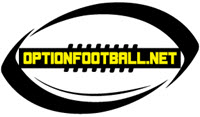
Albany, NY
OptionFootball.net
Feature Photo by Craig Strobeck
Related Articles:
Levi Steier, (Football Analyst) after a collegiate playing career cut short by injuries, began his coaching career as a student assistant at Dakota State University. Since then he has coached primarily at the high school level. During this time he has been a head coach and has coordinated all three phases of the game. He is currently the owner of a web design business and the publisher at OptionFootball.net where he discusses many aspects of football, but regularly focuses on option oriented football topics. Coach Steier enjoys talking football and encourages anyone who would like to discuss the game or find more information to visit his site. You can follow Levi on twitter @OptionFootball, on his Facebook page and on Google+.

